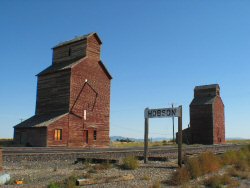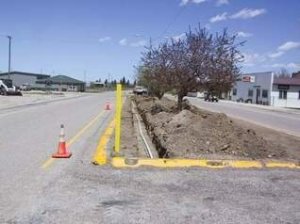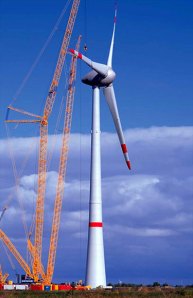There are some in Congress who think that it might be a good idea if you were to know how much and what kinds of toxic chemicals the oil and gas industry are pumping into your drinking water. Representative Diana DeGette (D-CO) has proposed a bill that would repeal a regulatory exemption for hydraulic fracturing, used in the production of natural gas wells. The story goes like this: Hydraulic Fracturing, or “Fracking” in the oilfield vernacular, is a process whereby tens of thousands of gallons of water, sand and chemicals are injected into a well under high pressure to release natural gas or CBM gases. Fracturing is used in nine out of every ten natural gas wells drilled in the United States. As much as a third of the fluids remain in the ground after the gas is produced and sometimes migrates to drinking water aquifers. Some of the chemicals used are known to cause cancer as well as kidney, liver, heart, blood and brain damage.
It’s a bit tough to determine just what damage the chemicals can do because the oil and gas companies consider the exact formula to be  “proprietary” and they are not required to reveal what chemicals they use, how much or where. Your friends in Congress passed the 2005 Energy Policy Act which exempted hydraulic fracturing from regulation under the Safe Water Drinking Act using a highly dubious study by the EPA which concluded in 2004 that the process “posed no risk to drinking water“. No other industry has such and exemption. EPA admits that four out of 10 streams and rivers in the west have been contaminated by mining. EPA is not allowed to regulate or set conditions for hydraulic fracturing or even to require states to set their own regulations. The new legislation would end this exemption. Rep. DeGette hopes to attach the bill to a larger piece of legislation such as the climate change bill or possibly a new energy policy bill.
“proprietary” and they are not required to reveal what chemicals they use, how much or where. Your friends in Congress passed the 2005 Energy Policy Act which exempted hydraulic fracturing from regulation under the Safe Water Drinking Act using a highly dubious study by the EPA which concluded in 2004 that the process “posed no risk to drinking water“. No other industry has such and exemption. EPA admits that four out of 10 streams and rivers in the west have been contaminated by mining. EPA is not allowed to regulate or set conditions for hydraulic fracturing or even to require states to set their own regulations. The new legislation would end this exemption. Rep. DeGette hopes to attach the bill to a larger piece of legislation such as the climate change bill or possibly a new energy policy bill.
In 2008, 1.6 million gallons of fracturing fluid leaked from a waste pit near Parachute, CO. The waste seeped into groundwater where it was transported to a nearby cliff face resulting in a 200-foot frozen toxic waterfall that eventually melted and made it’s way into the Colorado River. In another case, a house in Colorado exploded after fracturing caused methane to seep into the water supply. In Sublette County, Wyoming, benzene was discovered in a rural water well near one of the nations largest natural-gas fields. The EPA says that “it is hard to pinpoint the exact cause of each contamination or measure its spread accurately because the precise nature and concentrations of the chemicals used by industry are considered trade secrets”. Colorado has found “some 1,500 spills in drilling areas since 2003, more than 300 have seeped into water“. If you don’t know what to test for, it’s kind of hard to find what has leaked and if you find bad stuff in a water supply, it’s almost impossible to prove where it came from.
Reaction to the proposed bill by the oil and gas industry follows a sadly predictable theme. Consumers will pay hundreds of dollars a gallon for fuel. Tax receipts will plummet. Every oil company will go bankrupt and the country will lay in ruins should they be forced to comply with such oppressive regulation. They say that the states provide sufficient regulation and there is no need for federal oversight. I assume that it is easier to deal with 50 different sets of regulations than to reveal dirty secrets to the public. One thing you can bet on is that industry will fight this and similar bills with millions of dollars of their recent record profits.
Filed under: Button Valley News, Montana News, Montana Politics, Science | Leave a comment »



 The Kalispell anti-gay pride petition had been signed by some 200 righteous citizens, which according to my math is somewhere around 1% of the metropolitan population. A poll conducted last year by the
The Kalispell anti-gay pride petition had been signed by some 200 righteous citizens, which according to my math is somewhere around 1% of the metropolitan population. A poll conducted last year by the  Judith Basin County, is going to look a lot nicer. According to the
Judith Basin County, is going to look a lot nicer. According to the 
 One notable exception that was overlooked on the Dinosaur Trail is the new (Opening this month?)
One notable exception that was overlooked on the Dinosaur Trail is the new (Opening this month?)  a class that will discuss geology because it may claim that the earth is older than 10,000 years? Can a student be excused from biology class where evolution might be discussed? Scary thought that doctors could get a degree in Alberta without ever being exposed to the main tenet of biology. Could an English teacher be brought before the Human Rights Commission for reading from Oscar Wilde or Walt Whitman?
a class that will discuss geology because it may claim that the earth is older than 10,000 years? Can a student be excused from biology class where evolution might be discussed? Scary thought that doctors could get a degree in Alberta without ever being exposed to the main tenet of biology. Could an English teacher be brought before the Human Rights Commission for reading from Oscar Wilde or Walt Whitman? Yesterday, over at
Yesterday, over at  Americans have concluded that he is irrelevant. So, he decided to start a
Americans have concluded that he is irrelevant. So, he decided to start a 

